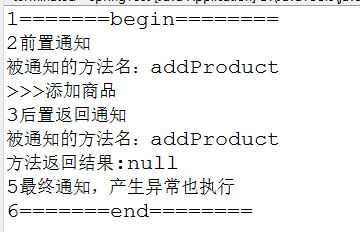06 Spring AOP
1、AOP概念
AOP就是面向切面编程,在原有方法的前边或者后边增加一些业务逻辑代码。
相关术语:
1、连接点:程序执行过程中的某个时间点。
2、切入点:就是需要切面编程的连接点。
3、通知:是在切入点前边或者后边要执行的一段代码,通知有分为:前置通知,后置通知,异常通知,最终通知和环绕通知等。
4、切面:指封装切入点和通知的一个类。
5、目标对象:被增强的对象。
2、通知类型说明
1、前置通知:在目标方法执行前实施增强。
2、后置返回通知:在目标方法执行后执行,如果产生了异常,则不会被执行。
3、后置最终通知:在目标方法执行后执行,有异常,也会被执行的通知。
4、异常通知:当目标方法执行过程中产生异常,则执行的通知。
5、环绕通知:在目标方法执行前和目标方法执行后执行的通知。
6、引入通知:在目标类中增加一些新的方法和属性,用来对目标类进行扩展。
3、AspectJ切入表表达式
基本语法:
1 | @Pointcut(value="execution(modifiers-pattern? ret-type-pattern declaring-type-pattern.methodName-pattern(param-pattern) throws-pattern?)") |
1)末尾有?的代表可以省略。
2)modifiers-pattern? 目标方法的修饰符匹配符,如public , private
3)ret-type-pattern 目标方法返回值匹配符,如void、string等,* 代表所有类型。
4)declaring-type-pattern 目标方法类路径匹配符,如cn.sjxy.service.UserService,*代表所有类型
5)methodName-pattern 目标方法名称匹配符,例如Insert,Update,*代表所有方法名。
6)param-pattern 目标方法参数匹配符,(..)代表所有的参数,包含无参方法。
7)throws-pattern? 目标方法抛出的异常类型
例如:
1 2 3 | //定义切入点,设定切入点表达式,方法名是切入点名称@Pointcut(value="execution(* cn.sjxy.Service.ProductService.*(..))")@Pointcut(value="execution(* cn.sjxy.Service.ProductService.addProduct(..))") |
4、AspectJ框架的使用 - 注解
1、pom.xml引入依赖包
1 2 3 4 5 6 7 8 9 10 11 12 13 14 15 16 17 18 19 20 21 22 23 24 25 26 27 28 29 30 31 | <project xmlns="http://maven.apache.org/POM/4.0.0" xmlns:xsi="http://www.w3.org/2001/XMLSchema-instance" xsi:schemaLocation="http://maven.apache.org/POM/4.0.0 https://maven.apache.org/xsd/maven-4.0.0.xsd"> <modelVersion>4.0.0</modelVersion> <groupId>cn.sjxy</groupId> <artifactId>chapter02Maven</artifactId> <version>0.0.1-SNAPSHOT</version> <dependencies> <!-- https://mvnrepository.com/artifact/org.springframework/spring-context --> <dependency> <groupId>org.springframework</groupId> <artifactId>spring-context</artifactId> <version>5.3.0</version> </dependency> <!-- https://mvnrepository.com/artifact/org.springframework/spring-aop --> <dependency> <groupId>org.springframework</groupId> <artifactId>spring-aop</artifactId> <version>5.3.0</version> </dependency> <!-- https://mvnrepository.com/artifact/org.springframework/spring-aspects --> <dependency> <groupId>org.springframework</groupId> <artifactId>spring-aspects</artifactId> <version>5.3.0</version> </dependency> </dependencies></project> |
2、applicationContext.xml 开启AspectJ注解使用方式
1 2 3 4 5 6 7 8 9 10 11 12 13 14 15 16 17 18 19 | <?xml version="1.0" encoding="UTF-8"?><beans xmlns="http://www.springframework.org/schema/beans" xmlns:xsi="http://www.w3.org/2001/XMLSchema-instance" xmlns:context="http://www.springframework.org/schema/context" xmlns:aop="http://www.springframework.org/schema/aop" xsi:schemaLocation="http://www.springframework.org/schema/beans http://www.springframework.org/schema/beans/spring-beans-2.5.xsd http://www.springframework.org/schema/context http://www.springframework.org/schema/context/spring-context-2.5.xsd http://www.springframework.org/schema/aop http://www.springframework.org/schema/aop/spring-aop-3.1.xsd"> <!-- 开启扫包 --> <context:component-scan base-package="cn.sjxy"/> <!-- 开启AspectJ 注解 --> <aop:aspectj-autoproxy /> </beans> |
3、业务类代码
1 2 3 4 5 6 7 8 9 10 11 12 13 14 15 16 17 18 19 20 21 22 23 24 25 26 27 28 29 | package cn.sjxy.Service;import org.springframework.stereotype.Service;@Service(value = "productService")public class ProductService { public void addProduct() { System.out.println(">>>添加商品"); int a=1,b=0,c; c=a/b; } public String findProduct() { System.out.println(">>>查看商品"); return "SSM框架"; } public void modifyProduct() { System.out.println(">>>修改商品"); } public void deleteProduct() { System.out.println(">>>删除商品"); }} |
4、切面类代码
1 2 3 4 5 6 7 8 9 10 11 12 13 14 15 16 17 18 19 20 21 22 23 24 25 26 27 28 29 30 31 32 33 34 35 36 37 38 39 40 41 42 43 44 45 46 47 48 49 50 51 52 53 54 55 56 57 58 59 60 61 62 | package cn.sjxy.Aspect;import org.aspectj.lang.JoinPoint;import org.aspectj.lang.ProceedingJoinPoint;import org.aspectj.lang.annotation.After;import org.aspectj.lang.annotation.AfterReturning;import org.aspectj.lang.annotation.AfterThrowing;import org.aspectj.lang.annotation.Around;import org.aspectj.lang.annotation.Aspect;import org.aspectj.lang.annotation.Before;import org.aspectj.lang.annotation.Pointcut;import org.springframework.stereotype.Component;@Component@Aspectpublic class MyAnnotationAspect { //定义切入点,设定切入点表达式,方法名是切入点名称 @Pointcut(value="execution(* cn.sjxy.Service.ProductService.addProduct(..))") private void myPointCut() {} //前置通知 @Before(value="myPointCut()") public void beforeAdvice(JoinPoint jp) { System.out.println("2前置通知"); System.out.println("被通知的方法名:"+jp.getSignature().getName()); } //后置返回通知,能够获取到方法的返回值,有异常,则不执行 @AfterReturning(value="myPointCut()",returning = "obj") public void afterReturningAdvice(JoinPoint jp,Object obj) { System.out.println("3后置返回通知"); System.out.println("被通知的方法名:"+jp.getSignature().getName()); System.out.println("方法返回结果:"+obj); } //环绕通知,在方法的前边和后边执行,有异常,则后边不再执行 @Around(value="myPointCut()") public Object roundAdvice(ProceedingJoinPoint pjp) throws Throwable{ System.out.println("1=======begin========"); Object resultValue = pjp.proceed(); System.out.println("6=======end========"); return resultValue; } //异常通知,产生异常时执行 @AfterThrowing(pointcut="myPointCut()",throwing="ex") public void exceptionAdvice(Throwable ex) { System.out.println("4异常通知:程序的运行异常为:"+ex.getMessage()); } //最终通知,有异常也执行 @After("myPointCut()") public void afterAdvice() { System.out.println("5最终通知,产生异常也执行"); }} |
5、测试类代码:
1 2 3 4 5 6 7 8 9 | public class SpringTest { public static void main(String[] args) { ApplicationContext context = new ClassPathXmlApplicationContext("applicationContext.xml"); ProductService s = (ProductService)context.getBean("productService"); s.addProduct(); }} |
6、执行结果截图 - 无异常

7、执行结果截图 - 有异常

3和6的通知不会被执行到。
欢迎阅读,有错误请留言指正。





【推荐】国内首个AI IDE,深度理解中文开发场景,立即下载体验Trae
【推荐】编程新体验,更懂你的AI,立即体验豆包MarsCode编程助手
【推荐】抖音旗下AI助手豆包,你的智能百科全书,全免费不限次数
【推荐】轻量又高性能的 SSH 工具 IShell:AI 加持,快人一步
· 25岁的心里话
· 闲置电脑爆改个人服务器(超详细) #公网映射 #Vmware虚拟网络编辑器
· 基于 Docker 搭建 FRP 内网穿透开源项目(很简单哒)
· 零经验选手,Compose 一天开发一款小游戏!
· 一起来玩mcp_server_sqlite,让AI帮你做增删改查!!